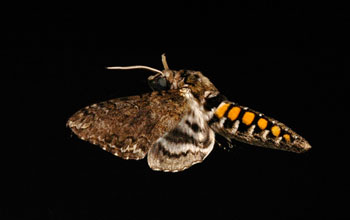Multimedia Gallery
Hawk Moth Manduca sexta (Image 1)
Hawk Moth Manduca sexta (Image 1)
The hawk moth Manduca sexta, hovering in front of a flower. The antennae of the moth act as gyroscopic sensors that help stabilize flight in low light conditions.
More about this Image
Two-winged insects such as houseflies and mosquitoes that are active during the light of day rely on their vision for flight control, but they also get help from organs called halteres, which grow where a second set of wings might otherwise be found and aid in navigation. But four-winged insects such as moths, that are most active during low-light times of the day, lack halteres. Scientists wondered how these insects are able to navigate with minimal light.
A research team, led by Sanjay Sane, a University of Washington postdoctoral researcher in biology, conducted an investigation using the hawk moth species Manduca sexta. Hawk moths are among crepuscular insects, which are most active during low-light times of the day, at twilight or just before dawn. Like other insects, their antennae allow them to smell. But the researchers suspected the antennae also provided moths with the means to stay on the proper heading while in flight.
To test the theory, Sane removed the long part of the antennae, called flagella, just above the Johnston's organ, a tiny structure just above the moth's head at the base of the antenna containing mechanosensors that detect motion in the flagella. When the light is low and the visual cues are hard to see, flying creatures have to depend more on the mechanosensory system to navigate.
He then observed as the insects tried to fly inside a dimly lit glass chamber. The antenna-less moths flew backwards, collided with walls or crashed to the floor much more often than those with antennae. Sane then used Super Glue to reattach the flagella and found that the insects' normal flight abilities were restored. He repeated the entire process again, removing the flagella and flight was impaired once more. "This showed it was the mechanical stimulus, and nothing else, that caused the effect," says Sane.
Sane found that hawk moths hold their antennae at relatively fixed positions to guide them while in flight. If a moth's body begins to turn in relationship to the antennae, stretch receptors, specialized neurons in the Johnston's organ, sense the movement and send signals to the brain so the insect can move its body back to the correct heading.
The researchers measured neural responses within the receptors to determine the frequency at which the signals were sent. The receptors receive information from a variety of stimuli, something like a radio having access to the entire FM band, but the Johnston's organ sends signals to the brain on a narrower frequency, concentrated at roughly twice the speed of the insect's wing beats. The brain pays particular attention to those signals, the scientists found, like tuning a radio to a specific FM station.
The research helps scientists understand locomotion, raises questions about how the mechanosensory system functions in long-distance moth migration, and could shed light on how the many forms of insect antennae found in nature actually work. A paper describing Sane's research was published in the Feb. 9 edition of the journal Science. You may view videos from Sane's research of a hawk moth a) in normal flight, b) flight after the antennae have been removed, and c) flight after antennae have been re-attached here: http://uwnews.washington.edu/ni/article.asp?articleID=30426.
This research was supported by a National Science Foundation Postdoctoral Research Fellowship in Interdisciplinary Informatics grant (DBI 03-06154). (Date of Image: Jan. 22, 2006) [One of two related images. See Next Image.]
Credit: Armin Hinterwirth, University of Washington, Dept. of Biology, Daniel Lab
Images and other media in the National Science Foundation Multimedia Gallery are available for use in print and electronic material by NSF employees, members of the media, university staff, teachers and the general public. All media in the gallery are intended for personal, educational and nonprofit/non-commercial use only.
Images credited to the National Science Foundation, a federal agency, are in the public domain. The images were created by employees of the United States Government as part of their official duties or prepared by contractors as "works for hire" for NSF. You may freely use NSF-credited images and, at your discretion, credit NSF with a "Courtesy: National Science Foundation" notation.
Additional information about general usage can be found in Conditions.
Also Available:
Download the high-resolution JPG version of the image. (611 KB)
Use your mouse to right-click (Mac users may need to Ctrl-click) the link above and choose the option that will save the file or target to your computer.

